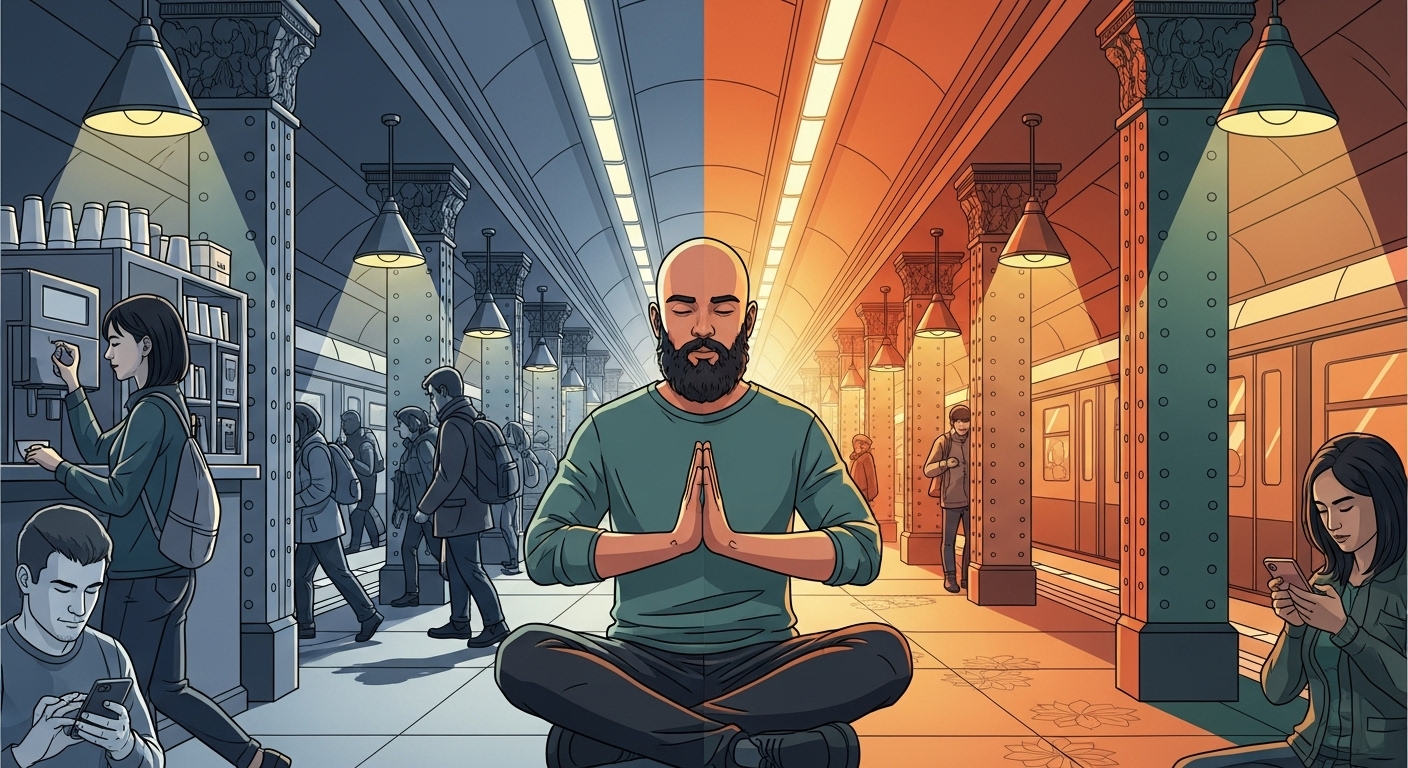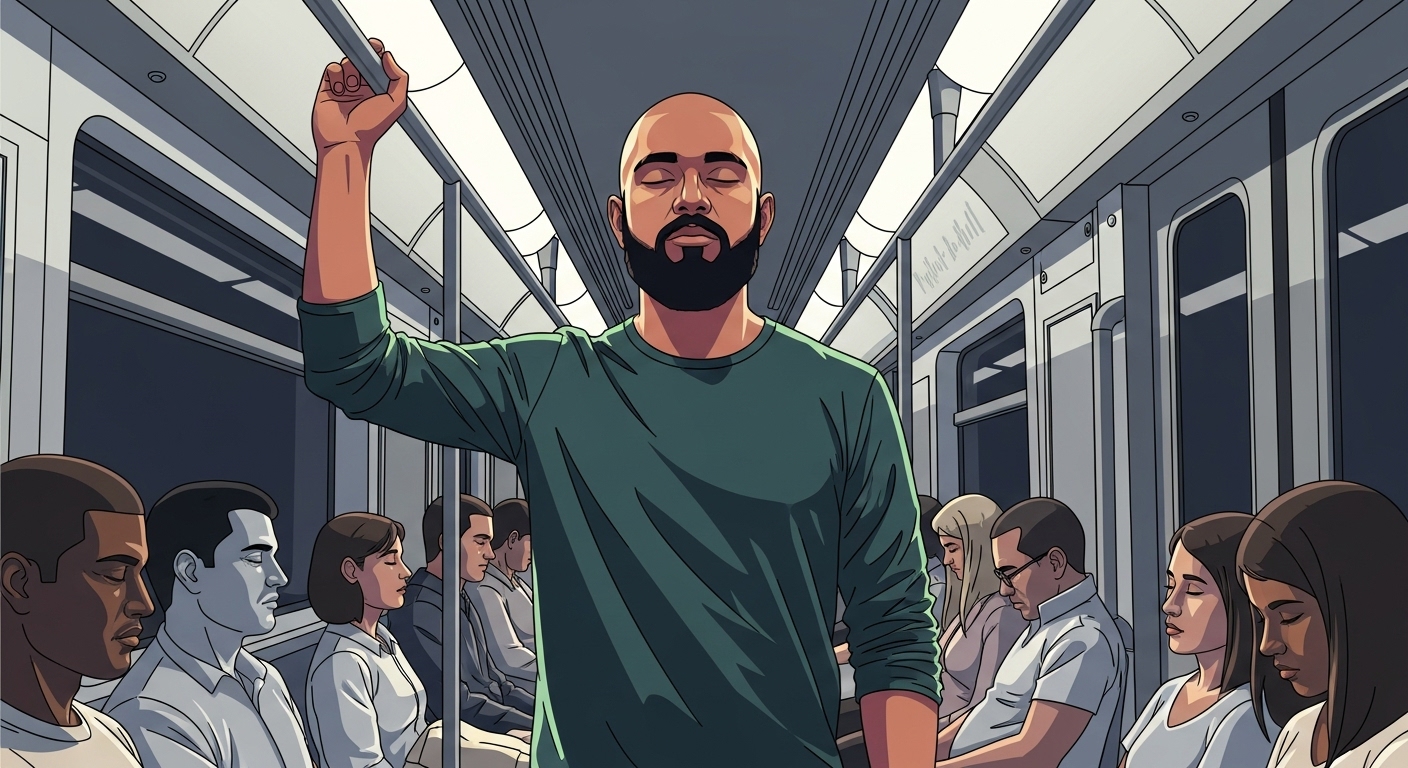The Urban Monastery Practice: Three Techniques That Transform Chaos into Calm
Transform your commute into a meditation retreat with these three practices that turn every delay, crowd, and interruption into a doorway to presence.

After that breakthrough in the broken-down train, I spent months developing what I now call the Urban Monastery Practice. Not despite the chaos of city life—because of it.
Here’s what I discovered: we don’t need to escape the city to find peace. We need to learn its hidden language. Every sound, every delay, every crowded space is actually calling us to presence. We just need the right techniques to hear it.
Technique 1: Breathing With the City
Forget fighting against your environment. This practice flows with it.
When you’re in any crowded space—subway, bus, elevator, wherever—try this:
Inhale: Breathe in everything around you. The sounds, the energy, even the stress. Don’t resist it. Welcome it all. Count to four as you draw it in.
Hold: Let it settle inside you for another count of four. You’re not holding your breath against the world. You’re letting the city’s energy find its place within you.
Exhale: This is where the magic happens. As you breathe out for six counts, you’re not pushing the energy away. You’re transforming it. Breathing out peace into the same space you breathed in chaos.
I do this three times at every subway stop. By the third breath, something shifts. You’re not separate from the city anymore. You’re part of its breathing.
The businessman who kicked the door that day? I started breathing with him instead of despite him. His frustration became part of my practice. His anger became my teacher. You can’t do that on a mountain. You need the friction.
Technique 2: Crowd Compassion
This one’s revolutionary. Instead of seeing crowds as obstacles, we use them as compassion multipliers.
Pick someone nearby. Anyone. The exhausted nurse checking her phone. The delivery guy balancing impossible packages. The teenager lost in his music. You don’t need their story. You just need to see them.
With each breath, silently offer:
- May you find peace in this chaos
- May you find ease in this difficulty
- May this day bring you closer to joy
Then expand. Include the person behind them. The one across from you. Keep growing your circle of silent blessing until your whole subway car becomes a sanctuary that only you know about.
Last week, I did this on a delayed 6 train. Started with one frazzled mom, expanded to include the whole car. By 86th Street, I swear the energy had shifted. People were making eye contact, offering seats, sharing small smiles.
Coincidence? Maybe. But I don’t think so. When you change your inner environment, the outer one responds.
Technique 3: The Interruption Bell
This is the advanced practice. Every city sound becomes a mindfulness bell.
That announcement crackling overhead? Instead of tuning it out, let it wake you up. Come back to your breath. That car horn? Don’t curse it. Thank it for reminding you where you are. That person talking too loudly on their phone? They’re your personal meditation teacher, calling you back to presence.
The city gives us hundreds of these bells every day. We just usually experience them as irritations instead of invitations.
Try this: Pick one sound that usually annoys you. Maybe it’s the subway brake squeal, maybe it’s construction noise, maybe it’s sirens. For one week, every time you hear it, take one conscious breath. That’s it. One breath of pure presence.
Watch what happens. The sound doesn’t change. But your relationship to it transforms completely.
The Practice in Action
Here’s how I combine all three:
Morning commute: Three breaths with the city at each stop. Include everyone in my car in silent compassion. Every announcement is a chance to return to presence.
Midday movement: Waiting for elevators, walking to lunch, standing in line—all become opportunities. One breath to arrive. One breath to bless others. One breath to thank the interruption.
Evening return: This is when we need it most. Everyone’s tired, frustrated, done. This is exactly when your practice matters. You become a pocket of calm in the storm. Without saying a word, you change the field around you.
The Mountain Is Already Here
Remember: You’re not trying to pretend the subway is a mountain monastery. You’re discovering that it already is one. The noise is your silence. The crowd is your sangha. The delay is your teacher.
Every spiritual tradition has a version of this truth. The Sufis dance in marketplaces. Zen masters find enlightenment in ordinary tasks. The Bhagavad Gita’s greatest teachings happen on a battlefield.
They’re all saying the same thing: Don’t wait for perfect conditions. Perfect conditions are already here, disguised as imperfection.
Your morning commute? That’s your walking meditation. Your crowded lunch spot? That’s your community practice. Your delayed train? That’s the universe giving you extra time to practice. You just got a free meditation retreat, and you’re complaining about it.
Next in this series: How to turn your entire city into a spiritual practice, and why the future of meditation isn’t about escaping our urban lives—it’s about fully embracing them.



